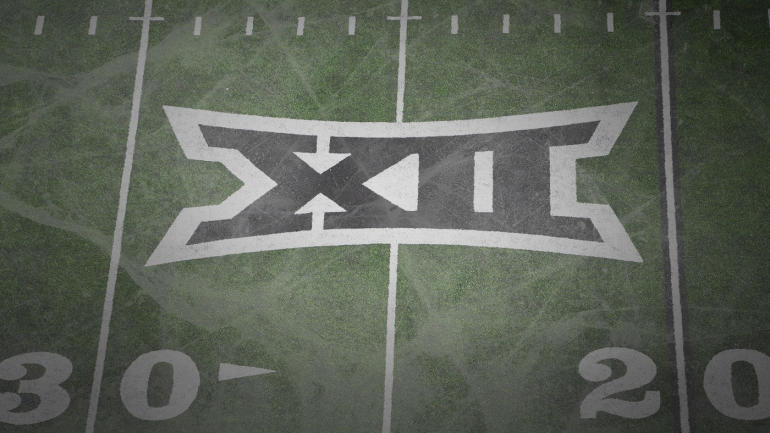
Texas and Oklahoma have taken the next step towards migrating to the SEC by declaring their intent to leave the Big 12 with a formal statement informing the conference they will not renew their grant of rights agreements once they expire in 2024-25. The shock that came when this news first broke last week hasn't worn off and won't for quite some time.
Two iconic programs who rule the Big 12 are about to swim into the deep end of the pool in the SEC if all goes as planned. On the field, Oklahoma is the No. 1 program in the Big 12. While it has struggled lately in football, Texas is still the richest athletic program in the nation with an endowment that nears $32 billion.
How does that fit in the SEC? Oklahoma might at best be -- what? -- the fourth-best program in the Strength Everywhere Conference. Is Texas fifth, maybe sixth? No matter where you come down on that discussion, the Big 12's two big dogs better be prepared to lose some of their swagger when they head Southeast. They will no longer the loudest most impactful voices in the room. This is going to take humility, a term that's never described either program historically. It's also going to reshuffle college athletics.
Now that the first bomb has dropped, let's take a look at what's next at Texas, Oklahoma, the SEC and the larger national landscape of college athletics.
Chance to change everything
This is more than a money play by the SEC. Sure, Texas and Oklahoma might get a nice bump in revenue by changing conferences. One conservative estimate put their share in the SEC at $64 million per year, up $20 million from what SEC teams are earning now. But unless ESPN is in the business of tearing up monster contracts in the middle of their terms, the existing 14 SEC schools will continue making the same revenue (approximately $44 million) through 2032. ESPN has all the leverage here. It owns have half the rights (with Fox) for Texas and Oklahoma. Why should it pay any more for this move?
Why should they pay even $1 more for this move?
That means this entire realignment, for the moment, must to be viewed through SEC commissioner Greg Sankey's dissatisfaction with the NCAA. Sankey has been public in his criticism, most recently Monday in a strident takedown of NCAA president Mark Emmert and his association at the opening of the 2021 SEC Media Days.
If the NCAA and Emmert are not going to lead college athletics, this move will position the SEC and Sankey to fill the void.
It may not be the most principled move stealing the Longhorns and Sooners, but as we learned a decade ago, there is no honor amongst conferences in realignment.
With the most best teams, the SEC will essentially be able to make its own rules. Why stop at a limit of 25 scholarships per year? The SEC could, on its own, go to 30. Why not 40? How about a 150-man roster?
Name, image and likeness rights has made it possible (and legal) for players to profit from their brand. That would have previously been an NCAA violation.
A Miami booster is essentially paying players for being on scholarship with the Hurricanes. Nick Saban claims Alabama quarterback Bryce Young has earned almost $1 million. Taken to a logical conclusion, there is going to be faction of programs that will pay players and enter into group licensing agreements. That hints of unionization.
Why stop there? Think reworked amateurism and eligibility rules. A streamlined enforcement model with more liberal rules where cases take weeks to be adjudicated instead of years. Think an SEC owned-and-operated streaming service that brings in even more money.
All of it has to be in play in the long term. There is simply no one around to stop the SEC. The NCAA is already on record as waving the white flag hoping that conferences will step up.
As much as anything else, this power play is about … power. Watch what the SEC does with its version of a 16-team superconference. (It may not even stop there.) With no central NCAA authority, there will be those who follow the SEC's athletic model and those who don't ... or can't, whether financially or otherwise.
"The autonomous conferences can determine who they are by themselves. They don't need any NCAA. They can just make it up as they go," one college consultant told CBS Sports.
If that just means four super conferences, it will continue the progress of what has already been a de facto breakaway by the Power Five. No matter what happens, the SEC might just have become the new NCAA.
Big Ten is on the clock
With Texas and Oklahoma on board, the SEC will at least have the potential to pass the Big Ten as the No. 1 revenue conference.
That almost compels the Big Ten to act. Its teams earn more than $50 million per year between TV rights, Big Ten Network money, bowl payouts and NCAA Tournament revenues. Its media rights contracts expire next year, so even without adding teams, the Big Ten and its members are due for a windfall.
But which teams out there add "pro rata"? In other words, which teams are worth proportional value of $50 million-plus per year?
The biggest remaining chips on the realignment board are Ohio State, Michigan, Notre Dame and USC. The Buckeyes and Wolverines aren't going anywhere. Notre Dame has shown no indication of assimilating into the ACC permanently after playing there (successfully, mind you) in 2020 due to COVID-19.
It's conceivable the big cigars at USC, tired of the underachieving Pac-12, could be interested in joining the Big Ten. That gives the Trojans better access to the playoff and certainly more money.
Such a move would probably involve getting travel partners in Washington, Colorado and possibly Arizona State. That would bring the Los Angeles, Seattle, Denver and Phoenix markets into the Big Ten. What would UCLA and Oregon (and Nike) have to say about that?
Don't sweat the travel. Geography ceased to matter in realignment long ago. Think of a West Coast scheduling "pod" that could include USC, Washington, Colorado, Arizona State, Nebraska and Iowa.
That's the next potential blockbuster, at least comparable to what the SEC just did. That's a Big Ten with conceivably seven of the top 16 TV markets in the country stretching coast-to-coast. Before all this occurred, Rutgers was handed a document from the Big Ten during its assimilation into the league. It stated the league's per school revenue would be $67 million by 2027. Now try to imagine if the West Coast joined in.
Kevin Warren being a rookie commissioner who struggled to align the Big Ten around COVID-19, it's hard to envision such a massive move for the conference. But with Texas' interest in the SEC spurred by a powerful board of regents chair, there are powerful forces above commissioners that could make this happen.
The Left Coast seems vulnerable in a Big 12 sort of way. However, the Big Ten could instead turn the other direction and try to beat the SEC to the punch in terms of world domination by going after Clemson and Florida State.
A source told CBS Sports over the weekend that Clemson is absolutely committed to the ACC.
Would Kansas be on the Big Ten's short list? Believe it or not, football remains the primary revenue driver at KU. Its languishing football program might be a plus in realignment. Big Ten football is strong enough to absorb a team that would be an automatic W despite it subtracting from overall schedule strength. It would be a no-brainer because Jayhawks basketball is a historically great program.
Interesting note: In the last round of realignment, former Big Ten commissioner Jim Delany went after some combination of Georgia Tech, North Carolin and Virginia. He settled for Maryland and Rutgers.
Delany brilliantly signed a short-term six-year TV deal that expires in 2022. With the Big Ten standing as the next major conference to renegotiate, will it sign a mini-extension to 2025 allowing its deal to sync up with those in the Big 12 if it wants to go after Kansas and/or Iowa State? Or will it take a giant swing and look West?
Warren was asked twice by CBS Sports over the weekend whether the SEC's move compelled the Big Ten to expand. He did not answer directly. "You could feel the ground in college athletics was going to shift," he said.
Pac-12 is in the hole
The best, smartest move by the Pac-12 would be taking in some remainder of the Big 12. Quickly. Stiff-arm a potential move by the Big Ten by expanding your conference East and ensuring you have a future.
Remember: Former Pac-12 commissioner Larry Scott tried for half the Big 12 just over a decade ago. When he told Texas it couldn't keep the Longhorn Network, the deal died. Times have changed. Drastically.
The eight remaining Big 12 schools need a home. It's unlikely that all of them would go to the Pac-12, but two -- Oklahoma State and Texas Tech -- would be attractive additions. That gets the Pac-12 into two states that could increase cable subscriptions (subscription fees) for its rightsholders.
If it does nothing, the Pac-12 is going to get a revenue bump after its current deal with ESPN and Fox expires in three years. There is also the diminished Pac-12 Network that apparently will continue but needs a massive reboot.
Like Warren, new Pac-12 commissioner George Kliavkoff is a rookie. Coupling that with the Pac-12's ongoing lack of on-field success or consistency, and the conference needs to make a bold move.
Any five-star prospect on the West Coast now has to take a serious look at the SEC first if they weren't already. The league is going to have the best access to the expanded playoff and the most potential teams in the soon-to-be-expanded field on an annual basis.
Yes, the SEC and Clemson have been going West recently to snag big-time talent. Texas and Oklahoma joining the league will extend that likelihood, making it less likely the Pac-12 gets out of its current football malaise -- 17 years without a national championship and only two College Football Playoff berths in seven years.
Big 12's sad, tragic potential end
In 2016, Iowa State athletic director Jamie Pollard made this prescient statement: "The Big 12 exists because we have Texas and Oklahoma in the room. If we take Texas and Oklahoma out of the room, we're the Mountain West Conference."
Those words hit like a sledgehammer today. As the SEC shocked the world by preparing to assume the 'Horns and Sooners, the Big 12 lost 50% to 75% of its value, several industry sources tell CBS Sports. Their TV contracts with ESPN and Fox contain language that allows the Big 12 networks to reduce payouts if there is a loss of membership.
"When you're losing two of the most visible programs, the network has the right to come and say, 'We're going to reduce the rights by X.'" one longtime, high-profile administrator said.
That means the Big 12 deal could drop from $37 million in annual revenue to as low as $9 million per school. Considering there aren't two schools available that come close to replacing the value of Texas and Oklahoma, the Big 12 is in troubled waters to say the least.
There's a real possibility the conference could be scattered to the four winds. What a shame. Iowa State, Kansas State, West Virginia and Baylor look particularly vulnerable. Those schools are neither in a major market nor an established national brand.
What's next? The Big 12 seems to be the hunted instead of the hunter. It retains autonomous (Power Five) legislative voting rights within the NCAA ... if it stays together. As mentioned, some Big 12 schools could find a lifeline in the Pac-12 -- just not all of them.
American the beautiful?
The American Athletic Conference has shown an interest in taking in at least some Big 12 schools. It flirted with Boise State last year. Does some combination of Oklahoma State, TCU, Baylor and Texas Tech make sense? Would the AAC eventually replace the Big 12 as a Power Five conference?
"You have to come with an aggressive idea that the conference not only is going to exist but the conference is going to develop a program that is going to make them stronger than what would be expected with the absence of Texas and Oklahoma," that source said.
If the Big 12 dissolves, everyone moves up a spot in college football's pecking order. That means the AAC all but becomes an automatic qualifier for the expanded playoff if you assume it is the next-strongest conference after what will then be the four super conferences (SEC, Big Ten, ACC, Pac-12).
In the suggested 12-team playoff, the top six conference champions get automatic bids. AAC commissioner Mike Aresco has long stumped for his league to receive "Power Six" status. That may now come by attrition.
Figure on the AAC adding at least one school to make it an even 12. The conference has 10 years to run on a 12-year deal with ESPN that is worth a reported $1 billion. Even in its current state, the worth of some Big 12 schools would be a boost to the AAC.
Mountain of a dark horse
The Mountain West is currently one year into a six-year TV rights deal that expires in 2026, one year after the Big 12. According to industry sources, it purposefully did a short-term deal so it could get to the open market quicker and in case the Big 12 imploded.
Kansas playing a conference basketball game at Air Force? It could happen.
Ugliness to come
The Big 12's grant of rights appears ironclad. The teams agreed to "grant" their TV rights to the Big 12 in the event any of them leave for another conference. (You can read the details here.)
In addition to an estimated $80 million early exit fee, Texas and Oklahoma would have to litigate that grant of rights deal to leave before the current Big 12 contract expires in 2025. As cash rich as those universities may be, do they have the appetite to wage that financial battle?
The UT and OU joint statement notes that they are willing to wait the contract out, but if the rest of the Big 12 crumbles around them, perhaps they can slide out early without a massive fee. That all remains to be seen, but whenever it comes to contracts and money, a long, ugly exit is to be expected.
Four more years of Texas and Oklahoma in Big 12 stadiums/arenas knowing all along each is just playing out the string having lobbed a middle finger at the rest of the league? Keep your helmets on, boys.





















